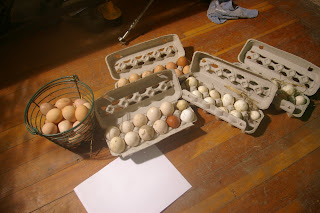 This poult is about 3 minutes out of the egg, all wet and wobbly, peeping a little.
This poult is about 3 minutes out of the egg, all wet and wobbly, peeping a little. I've found that turkey poults are more challenging to raise than chickens. So here's the regimen I use to minimize turkey poult loss:
1) I hatch my own. Shipping losses from hatcheries last year were 30% out of the box, and that sucks when they cost $9-12/each. No shipping means no shipping stress, better survival.
2) They stay in the brooder until they're warm and dry, usually 12 hours after they hatch. Starting warm and dry is pretty important.
3) The lights in the brooding bin are set close enough to make the wood chip surface 103 degrees. The turkey poults will move into this "hot" area and out of it and regulate their own temperature. So there's a 1 square foot area of "hot" and the rest of the area is various levels of heat less than that.
4) For the first two days I put a layer of newspaper over the chips. Turkeys will eat the chips, fill their stomach with it, and die. The newspaper prevents them from eating the chips. Yes, you do run a risk of spraddle, but I've never lost a turkey to spraddle and i've lost quite a few to wood chips. You remove the paper after the first two days or if it gets wet or slick.
5) I have chickens, and I supplement a high-protein chick starter with crumbled hard boiled chicken eggs. In my opinion, turkeys cannot have too much protein.
6) In the feed, and the water, I put a handful of clear glass marbles. The type people put in vases to hold flowers up. The turkeys are irresistibly attracted to shiny and they peck at the shiny marbles, and their beak slides off and into the food and water. They get the the idea faster this way.
7) as I put each turkey into the brooder I dip its beak into the water.
8) after all of the turkeys are in the bin, I tap on the food. They run over to see what the tapping is, and they try to peck my finger, and then the food. This seems to help them get it.
9) I put two or three chicken chicks in with each group of 20 turkeys. The chickens understand the food and water situation, and the turkeys watch them, and figure it out based on that. Yes, you run the risk of losing turkeys to blackhead disease but my experience has been ok so far.
If I do all of these things, I'll only lose 2-3% of the turkeys in the first 4 weeks. If I skip any of these steps I'll lose a progressively larger percentage. If I treat these little turkeys identically to chicken chicks, I'll typically lose 30-40%.





















































